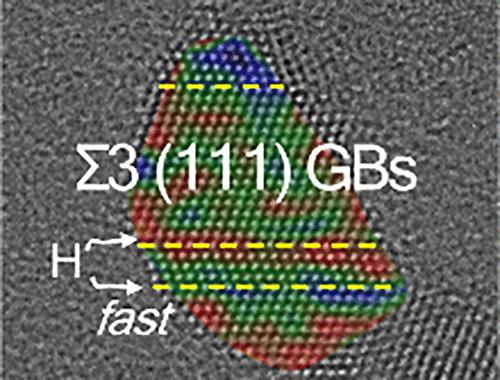Σ3(111) Grain Boundaries Accelerate Hydrogen Insertion into Palladium Nanostructures
IF 9.1
1区 材料科学
Q1 CHEMISTRY, MULTIDISCIPLINARY
引用次数: 0
Abstract
Grain boundaries (GBs) are frequently implicated as key defect structures facilitating metal hydride formation, yet their specific role remains poorly understood due to their structural complexity. Here, we investigate hydrogen insertion in Pd nanostructures enriched with well-defined Σ3(111) GBs (PdGB) synthesized via electrolysis-driven nanoparticle assembly. In situ synchrotron X-ray diffraction reveals that PdGB exhibits dramatically accelerated hydriding and dehydriding kinetics compared with ligand-free and ligand-capped Pd nanoparticles with similar crystallite sizes. Strain mapping using environmental transmission electron microscopy shows that strain is highly localized at GBs and intensifies upon hydrogen exposure, indicating preferential hydrogen insertion along GB sites. Density functional theory calculations provide mechanistic insight supporting these findings, showing that hydrogen insertion near Σ3(111) GBs is energetically more favorable and that tensile strain lowers insertion barriers. These results provide atomic-level insights into the role of GBs in hydride formation and suggest new design strategies for GB-engineered Pd-based functional materials.

Σ3(111)晶界加速氢插入到钯纳米结构
晶界(GBs)经常被认为是促进金属氢化物形成的关键缺陷结构,但由于其结构的复杂性,人们对其具体作用知之甚少。在这里,我们通过电解驱动的纳米颗粒组装研究了氢在富含明确定义的Σ3(111) gb (PdGB)的Pd纳米结构中的插入。原位同步x射线衍射表明,与晶体尺寸相似的无配体和有配体的Pd纳米粒子相比,PdGB的氢化和脱氢动力学显著加快。利用环境透射电镜绘制的应变图显示,菌株高度定位于GB位点,并在氢暴露时增强,表明氢优先沿GB位点插入。密度泛函理论计算提供了支持这些发现的机制,表明氢在Σ3(111) gb附近的插入在能量上更有利,拉伸应变降低了插入障碍。这些结果为gb在氢化物形成中的作用提供了原子水平的见解,并为gb工程pd基功能材料的设计提供了新的策略。
本文章由计算机程序翻译,如有差异,请以英文原文为准。
求助全文
约1分钟内获得全文
求助全文
来源期刊

Nano Letters
工程技术-材料科学:综合
CiteScore
16.80
自引率
2.80%
发文量
1182
审稿时长
1.4 months
期刊介绍:
Nano Letters serves as a dynamic platform for promptly disseminating original results in fundamental, applied, and emerging research across all facets of nanoscience and nanotechnology. A pivotal criterion for inclusion within Nano Letters is the convergence of at least two different areas or disciplines, ensuring a rich interdisciplinary scope. The journal is dedicated to fostering exploration in diverse areas, including:
- Experimental and theoretical findings on physical, chemical, and biological phenomena at the nanoscale
- Synthesis, characterization, and processing of organic, inorganic, polymer, and hybrid nanomaterials through physical, chemical, and biological methodologies
- Modeling and simulation of synthetic, assembly, and interaction processes
- Realization of integrated nanostructures and nano-engineered devices exhibiting advanced performance
- Applications of nanoscale materials in living and environmental systems
Nano Letters is committed to advancing and showcasing groundbreaking research that intersects various domains, fostering innovation and collaboration in the ever-evolving field of nanoscience and nanotechnology.
 求助内容:
求助内容: 应助结果提醒方式:
应助结果提醒方式:


